So I’ve seen these glasses advertised around the web and on Facebook talking about how EMT’s and Paramedics are using them to see veins for IV starts and to identify blood pooling, such as in hematomas. I reached out to O2 Amp by 2ai Labs, and they sent me four different sets of these glasses to evaluate and report back on.
The Claims: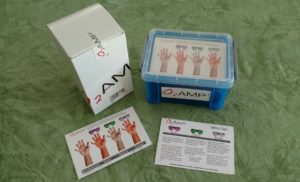
See veins more distinctly, identify blood pooling, see shifts in blood concentration in tissues (i.e., blanching, or capillary refill or lack thereof).
The Premise; How does it work:
Color shifts in vision can enhance the viewing of certain color spectra, allowing the user to perceive certain colors with more intensity, such as veins and capillaries.
By tinting the lenses, a color shift is introduces that obscures the undesirable range of color and enhances others. This is a tough one to tackle, because people don’t all perceive colors identically. For instance, I have a bit of color-blindness, which is not uncommon for men. I noticed that I perceived some things less intently than other users I shared this experience with, and other things more intensely than others.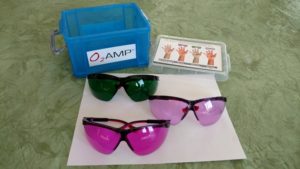
In order for most of these glasses to do what we expect of them, you will require a pretty strong light. In fact, the manufacturer recommends you start learning how to use these glasses in full sunlight. I agree. Alternatively, exam lights and tactical flashlights offer very strong light to help make these glasses work for you most efficiently. My best results were obtained in direct sunlight.
My results:
I tried taking these to our only regional trauma center’s ER and worked with a couple nurses and a few medics that passed through while I was there. Results were not exactly overwhelming. Even with a tactical flashlight emitting over 300 lumens, I and the others that were using them were still not feeling like we had fared any better with or without the glasses. There are a couple possible reasons that things didn’t go so swimmingly:
- Doubt/Bias: Any product that claims to allow one to perceive something differently by just applying a tint to your eyes seems dubious.
- Experience: We work under ostentatious circumstances and we in the ER and in the field are often called to be expert phlebotomists, finding veins where there seem to be none readily available and starting IV’s and performing blood draws. We have additional training and experience in gaining IV access beyond the typical clinical provider. The only medical staff I have encountered that are on par with emergency personnel are surgical suite medical staff and blood bank phlebotomists (incidentally, I worked in a whole blood donation bank for almost a year and that is where I gained a significant portion of my own phlebotomy skills). One nurse who tried the glasses said maybe I should take these to the floor nurses and let them try, since they don’t do too many IV’s comparatively.
- It’s a scam: Yes, it’s possible, but I don’t think it is likely. I have read the literature provided by the manufacturer and I don’t believe it is a scam.
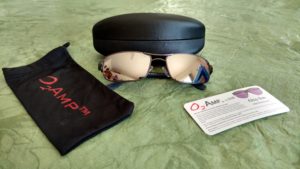 I also took these glasses to my EMS station and worked with a few fellow medics to see what they thought. We were already outside doing simulations and it seemed like the perfect time. Of the four varying tints of glasses we tried, they all yielded positive results, but the darkest of the purple tints, the sunglasses style O2 Amp glasses, showed the most benefit in finding veins. Tactical flashlights just didn’t do these glasses as much justice as the sunlight. Maybe the LED doesn’t emit a broad enough light spectrum to compare with sunlight. The end result was that provided you had a bright enough light, like sunlight, they worked fairly well. In the back of the ambulance with all the lighting up and the tac light, you could still do well with these glasses.
I also took these glasses to my EMS station and worked with a few fellow medics to see what they thought. We were already outside doing simulations and it seemed like the perfect time. Of the four varying tints of glasses we tried, they all yielded positive results, but the darkest of the purple tints, the sunglasses style O2 Amp glasses, showed the most benefit in finding veins. Tactical flashlights just didn’t do these glasses as much justice as the sunlight. Maybe the LED doesn’t emit a broad enough light spectrum to compare with sunlight. The end result was that provided you had a bright enough light, like sunlight, they worked fairly well. In the back of the ambulance with all the lighting up and the tac light, you could still do well with these glasses.
My verdict: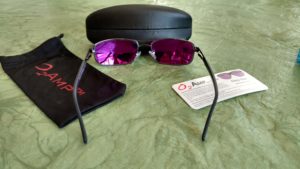
The O2 Amp glasses by 2ai Labs are a promising development in rapid vein identification. Caveats are warranted for people with color blindness – your mileage may vary – but that is why I enlisted the help of many other practitioners to help me properly evaluate these glasses. As the manufacturer claims, they are an alternative to the more expensive Vein Light devices. They seem to deliver fairly well, when placed under more ideal circumstances. They may not be the best in helping in low-light circumstances, of which EMS’ers find themselves in abundance of. I’m happy to have been given the opportunity to try these glasses out. On another note, I have been in contact with the manufacturer several times since receiving these glasses, and they have been helpful in ensuring I get the best results from my product evaluation. I think their customer service has been excellent.
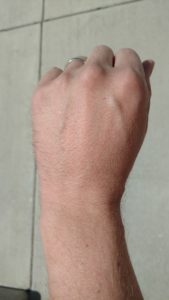
My forearm in bright sunlight. Decent enough veins.
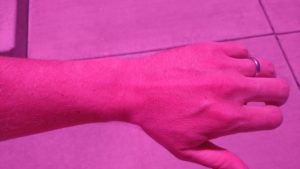
Bare arm in direct sunlight. Oxy-Iso Sunglasses placed over the lens of the camera. Results in the image are not as evident as with the naked eye. The blue tint in the veins is more prevalent. Smaller, less bulging veins are more noticeable when viewing through the glasses than through the camera. The difference is probably due to automatic color correction of the camera in processing the digital image.
Update:
I have been asked by O2 Amp to include the following notes, which may help their users get the most out of their glasses purchase and to clarify some of the science behind why their product works:
Thanks, Chris, for reviewing our product.
Some follow-up notes:
(1) We like to emphasize that, If one should be wearing protective glasses anyway, then one might as well wear glasses that enhance health signs and veins. If lighting conditions are good, then you get perceptual advantages. But if lighting conditions are not good, well, then it becomes basically clear protective eyewear. So, we view them less as a competitor among the vein finders, and more of a “wear these protective eyewear instead and you’ll sometimes — with good light — get perceptual advantages.”
(2) The Oxy-Iso is stronger in some sense, indeed, than the Oxy-Amp Paramedic Vein Glasses. But (a) the Oxy-Iso also cuts out a lot more light, making it even more difficult indoors, and (b) it blocks the other blood dimension we can see, variations in concentration of blood (what the green Hemo-Iso amplifies), making one better at seeing veins, but potentially worse at seeing clinical signs more generally. That’s why we recommend the Oxy-Amp Paramedic Vein Glasses to paramedics, because it blocks only a very narrow band of bad signal (and the light pink is a functionless side effect of the way we have to manufacture it), and so leaves one’s general clinical sense unhurt, but only better. …because paramedics need their general clinical signs sense intact.
(3) It’s more than just tints that make the tech work. I realize you’re speaking without jargon for a general audience, but, say, merely finding some filter (or colored glass, say) having the same tint won’t reproduce the effect. It has to have the spectral filter function of ours. (Said differently, for any tint, there are infinitely many spectra that differ in how they modify colors, but still all have the same tint.)
(4) In our experience, the Oxy-Amp is not successful for hospital workers — perhaps because they’re more a hostage to interior lighting constraints, or are less the type that carries tool kits around with them — than paramedics, where we have had good results.
(5) Even though paramedics tend to do their procedures inside the truck, their initial encounter is usually outside the truck, and in daylight the Oxy-Amp makes all clinical signs easier to see, not just veins. Out hope is that paramedics have our Oxy-Amp tech as their sunwear, so they get the UV protection needed, but also clinical enhancement.
Thanks again.
Mark
Dr. Mark Changizi
co-founder, http://o2amp.com
neuroscientist, http://www.changizi.com


2 Comments
Leave a reply →